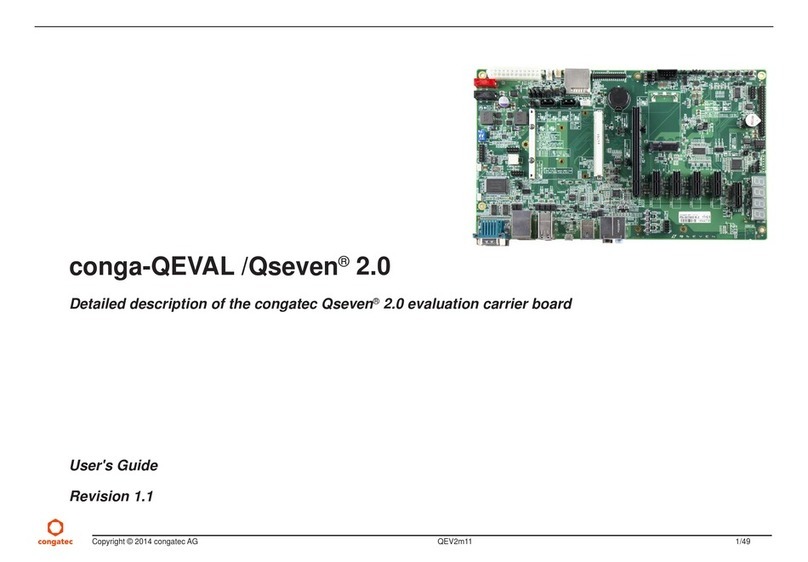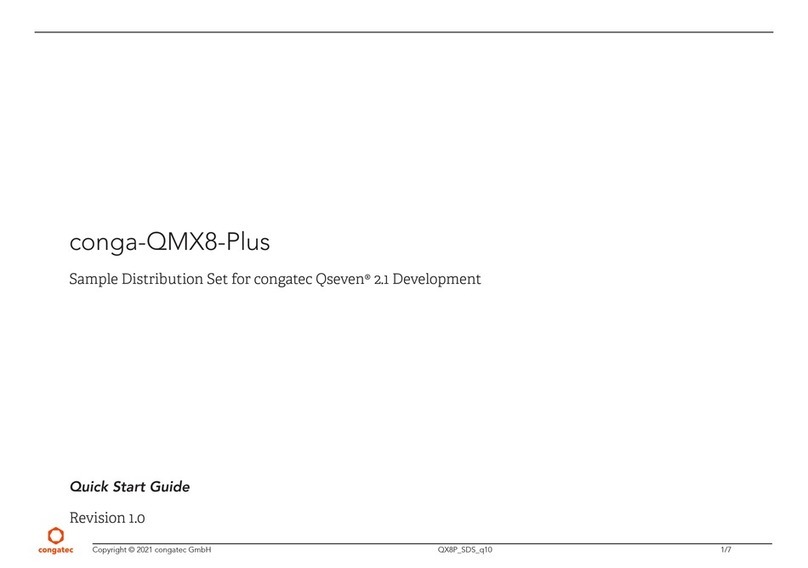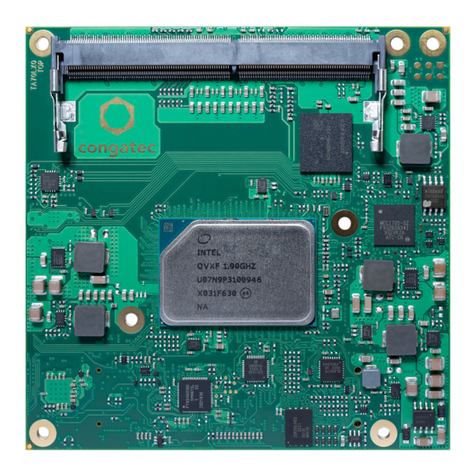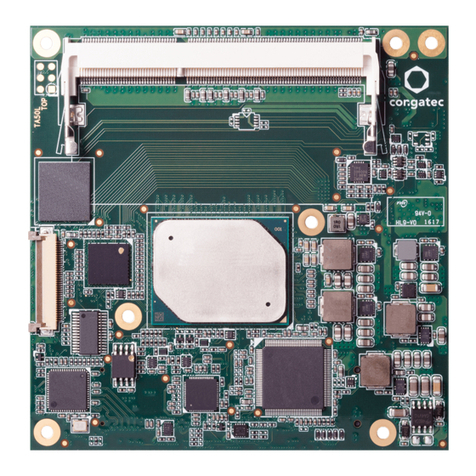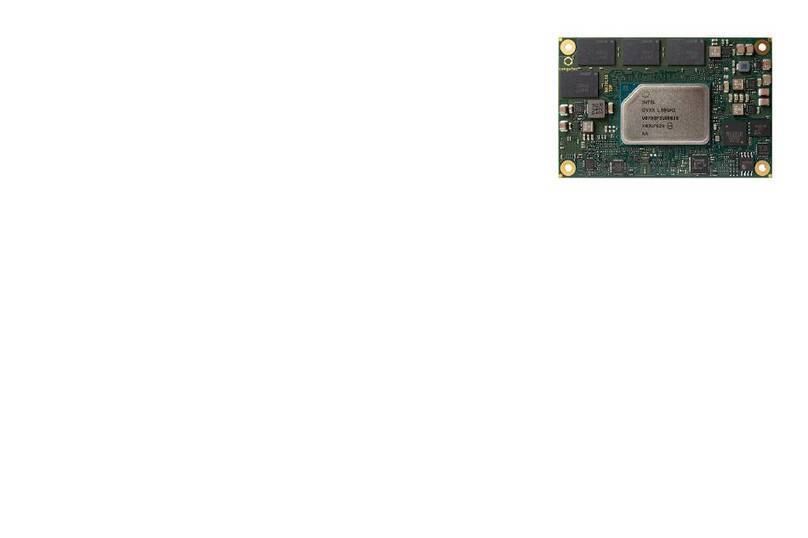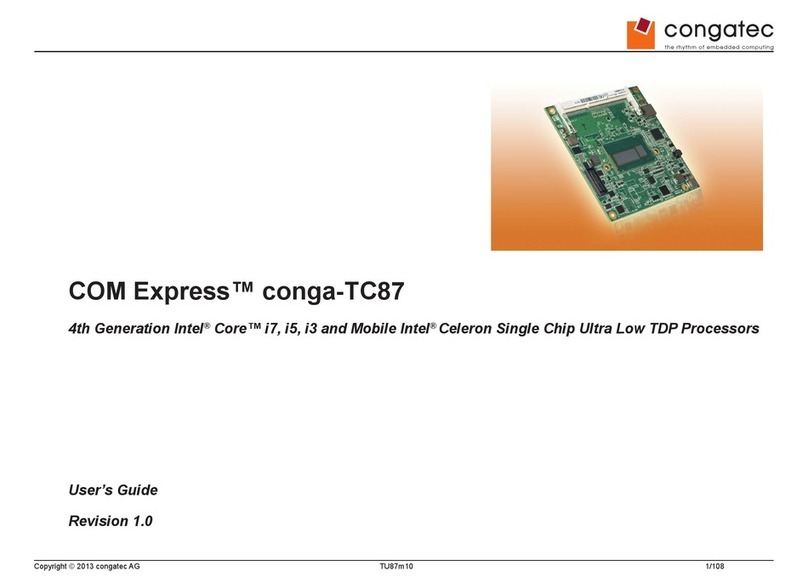Copyright © 2008 congatec AG B915m10 9/92
Contents
1 Specications........................................................................... 12
1.1 Feature List.............................................................................. 12
1.2 Supported Operating Systems................................................. 13
1.3 Mechanical Dimensions........................................................... 13
1.4 Supply Voltage Standard Power .............................................. 14
1.4.1 Electrical Characteristics.......................................................... 14
1.4.2 Rise Time................................................................................. 14
1.5 Power Consumption................................................................. 15
1.5.1 Intel® Celeron M 600MHz 512k L2 cache ............................... 16
1.5.2 Intel® Celeron M 1.0GHz 512k L2 cache ................................. 17
1.5.3 Intel® Celeron M 1.5GHz 1MB L2 cache.................................. 17
1.6 Supply Voltage Battery Power ................................................. 17
1.6.1 CMOS Battery Power Consumption ........................................ 18
1.7 Environmental Specications................................................... 18
2 Block Diagram.......................................................................... 19
3 Heatspreader ........................................................................... 20
3.1 Heatspreader Dimensions ....................................................... 21
4 Connector Subsystems Rows A, B, C, D................................. 22
4.1 Primary Connector Rows A and B............................................ 23
4.1.1 Serial ATA™ (SATA)................................................................. 23
4.1.2 USB 2.0.................................................................................... 23
4.1.3 AC’97 Digital Audio Interface/HDA........................................... 23
4.1.4 Gigabit Ethernet ...................................................................... 23
4.1.5 LPC Bus................................................................................... 24
4.1.6 I²C Bus 400kHz........................................................................ 24
4.1.7 PCI Express™ ......................................................................... 24
4.1.8 ExpressCard™......................................................................... 24
4.1.9 Graphics Output (VGA/CRT) ................................................... 24
4.1.10 LCD.......................................................................................... 24
4.1.11 Power Control .......................................................................... 25
4.1.12 Power Management................................................................. 26
4.2 Secondary Connector Rows C and D...................................... 26
4.2.1 PCI Express Graphics (PEG)................................................... 26
4.2.2 SDVO....................................................................................... 26
4.2.3 PCI Bus.................................................................................... 26
4.2.4 IDE (PATA) ............................................................................... 26
5 Additional Features .................................................................. 27
5.1 Watchdog................................................................................. 27
5.2 Onboard Microcontroller .......................................................... 27
5.3 Embedded BIOS...................................................................... 27
5.3.1 Simplied Overview of BIOS Setup Data Backup.................... 28
5.4 Security Features..................................................................... 29
5.5 Suspend to Ram ...................................................................... 29
5.6 congatec Battery Management Interface................................. 29
6 conga Tech Notes .................................................................... 30
6.1 Comparison of I/O APIC to 8259 PIC Interrupt mode .............. 30
6.2 Native vs. Compatible IDE mode............................................. 30
6.2.1 Compatible Mode..................................................................... 30
6.2.2 Native ...................................................................................... 30
6.3 Intel® Processor Features ........................................................ 31
6.3.1 Thermal Monitor and Catastrophic Thermal Protection ........... 31
6.3.2 Processor Performance Control............................................... 32
6.4 Thermal Management.............................................................. 33
6.5 ACPI Suspend Modes and Resume Events ............................ 34
6.6 USB 2.0 EHCI Host Controller Support ................................... 36
7 Signal Descriptions and Pinout Tables..................................... 37
7.1 A-B Connector Signal Descriptions.......................................... 38
7.2 A-B Connector Pinout .............................................................. 45
7.3 C-D Connector Signal Descriptions ......................................... 47
7.4 C-D Connector Pinout.............................................................. 53
7.5 Boot Strap Signals ................................................................... 55
8 System Resources................................................................... 56
8.1 System Memory Map............................................................... 56
8.2 I/O Address Assignment........................................................... 57
8.2.1 LPC Bus................................................................................... 58
